A 529 plan is a tax-advantaged investment vehicle in the United States designed to encourage saving for the future higher education expenses of a designated beneficiary. In 2017, K–12 public, private, and religious school tuition were included as qualified expenses for 529 plans along with post-secondary education costs after passage of the Tax Cuts and Jobs Act.

Bright Futures is the name of a scholarship program in the state of Florida. It is funded by the Florida Lottery and was first started in 1997.

The National Merit Scholarship Program is a United States academic scholarship competition for recognition and university scholarships administered by the National Merit Scholarship Corporation (NMSC), a privately funded, not-for-profit organization based in Evanston, Illinois. The program began in 1955.
Student financial aid in the United States is funding that is available exclusively to students attending a post-secondary educational institution in the United States. This funding is used to assist in covering the many costs incurred in the pursuit of post-secondary education. Financial aid is available from federal and state governments, educational institutions, and private organizations. It can be awarded in the form of grants, loans, work-study, and scholarships. In order to apply for federal financial aid, students must first complete the Free Application for Federal Student Aid (FAFSA).
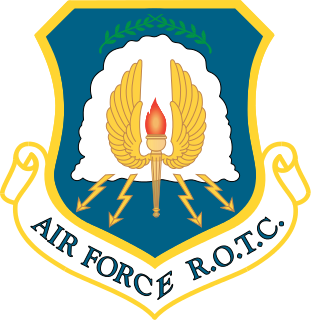
The Air Force Reserve Officer Training Corps (AFROTC) is one of the three primary commissioning sources for officers in the United States Air Force and United States Space Force, the other two being the United States Air Force Academy (USAFA) and Air Force Officer Training School (OTS). A subordinate command of the Air University within the Air Education and Training Command (AETC), AFROTC is aligned under the Jeanne M. Holm Center for Officer Accessions and Citizen Development at Maxwell AFB, Alabama. The Holm Center, formerly known as the Air Force Officer Accession and Training Schools (AFOATS), retains direct responsibility for both AFROTC and OTS.

The HOPE Program created in 1993 under the supervision of Georgia Governor Zell Miller, is Georgia's scholarship and grant program that rewards students with financial assistance in degree, diploma, and certificate programs at eligible Georgia public and private colleges and universities, and public technical colleges. HOPE is funded entirely by revenue from the Georgia Lottery and is administered by the Georgia Student Finance Commission (GSFC). Students can benefit from HOPE in several ways. “ There are multiple states in the country that offer the HOPE or some version of the HOPE to students who meet the requirements. “Always check with your state affiliated Educational website to ensure you are receiving as much financial help as possible.”
A Pell Grant is a subsidy the U.S. federal government provides for students who need it to pay for college. Federal Pell Grants are limited to students with financial need, who have not earned their first bachelor's degree, or who are enrolled in certain post-baccalaureate programs, through participating institutions. Originally known as a Basic Educational Opportunity Grant, it was renamed in 1980 in honor of Democratic U.S. Senator Claiborne Pell of Rhode Island. A Pell Grant is generally considered the foundation of a student's financial aid package, to which other forms of aid are added. The Federal Pell Grant program is administered by the United States Department of Education, which determines the student's financial need and through it, the student's Pell eligibility. The U.S. Department of Education uses a standard formula to evaluate financial information reported on the Free Application for Federal Student Aid (FAFSA) for determining the student's Expected Family Contribution (EFC).
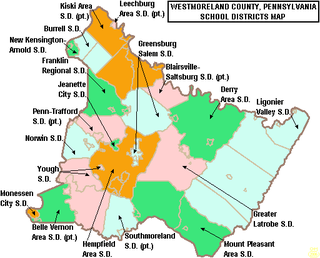
The New Kensington–Arnold School District is a small, suburban, public school district serving the cities of Arnold and New Kensington, located in northern Westmoreland County in the U.S. state of Pennsylvania. The New Kensington–Arnold School District encompasses approximately 5 square miles (13 km2). According to 2000 federal census data, it served a resident population of 20,400. By 2010, the District's population declined to 18,265 people. In 2009, the District residents’ per capita income was $16,285, while the median family income was $36,720. In Westmoreland County, the median household income was $50,736. In the Commonwealth, the median family income was $49,501 and the United States median family income was $49,445, in 2010. The educational attainment levels for the New Kensington–Arnold School District population were 89.4% high school graduates and 15.4% college graduates. The District is one 17 public school districts in Westmoreland County and one of the 500 public school districts of Pennsylvania.
Education in Missouri is provided by both public and private schools, colleges, and universities, and a variety of public library systems. All public education in the state is governed by the Missouri State Board of Education, which is made up of eight citizens appointed by the Governor of Missouri and confirmed by the Missouri Senate.
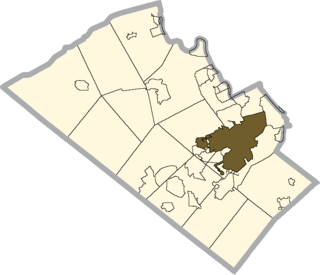
The Allentown School District is a large, urban public school district located in Lehigh County, Pennsylvania, in the United States. The district is one of the 500 public school districts of Pennsylvania. Serving most of the city of Allentown, it is the fourth largest school district in Pennsylvania, with 16,234 students, with 9.9% White, 14.5% Black, 70.9% Hispanic, 1.3% Asian, 0.2% Native American The school district of the City of Allentown encompasses approximately 17 square miles (44 km2). According to 2010 federal census data, the Allentown School District serves a resident population of 118,032. Per the US Census Bureau data, it served a resident population of 106,630 in 2000. In 2009, the per capita income was $16,282, while the median family income was $37,356. In the Commonwealth, the median family income was $49,501 and the United States median family income was $49,445, in 2010. By 2013, the median household income in the United States rose to $52,100.
Cal Grant is a financial aid program administrated by the California Student Aid Commission (CSAC) providing aid to California undergraduates, vocational training students, and those in teacher certification programs. Cal Grants are the largest source of California state funded student financial aid.
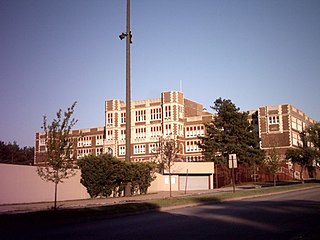
The Northwest Pennsylvania Collegiate Academy, or just Collegiate Academy or Academy High School, is located in midtown Erie, Pennsylvania. The school is housed in the former Academy High School building, which reopened in September 1992 as Collegiate Academy. The school boasts a 100% college acceptance rate among recent graduates.

The East Allegheny School District is a small, suburban, public school district covering the Boroughs of East McKeesport, Wall and Wilmerding and North Versailles Township in Allegheny County, Pennsylvania. The district encompasses approximately 5 square miles (13 km2). According to 2000 federal census data, it served a resident population of 16,340. By 2010, the district's population declined to 15,128 people. In 2009, the residents' per capita income was $16,497, while the median family income was $37,169. In the Commonwealth, the median family income was $49,501 and the United States median family income was $49,445, in 2010.

The Sharon City School District is a small, urban, public school district serving the city of Sharon, Pennsylvania on the western edge of the state. Sharon City School District encompasses approximately 5 square miles (13 km2). According to 2000 federal census data, it serves a resident population of 16,328. In 2009, the district residents’ per capita income was $15,913, while the median family income was $34,581. In the Commonwealth, the median family income was $49,501 and the United States median family income was $49,445, in 2010. By 2010, Sharon City School District's population declined to 14,028 people.

The Bristol Borough School District is a diminutive, suburban, public school district located in southern Bucks County, Pennsylvania. The district serves the Borough of Bristol. It encompasses just 1.7 square miles (4.4 km2), with a population of 12,000 people at the 1990 federal census. According to 2000 federal census data, it served a resident population of 9,923 people. By 2010, the cistrict's population declined further to 9,729 people. In 2009, Bristol Borough School District residents’ per capita income was $17,198, while the median family income was $44,517. In the Commonwealth, the median family income was $49,501 and the United States median family income was $49,445, in 2010.
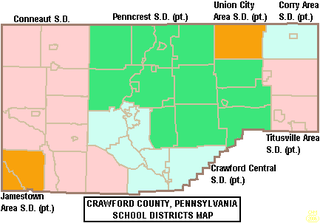
The Crawford Central School District is a midsized, public school district in Crawford county, Pennsylvania. It serves the City of Meadville, Borough of Cochranton and East Fairfield Township, Fairfield Township, Union Township, Vernon Township, Wayne Township and West Mead Township in Crawford County, Pennsylvania, as well as French Creek Township in neighboring Mercer County, Pennsylvania. Crawford Central School District encompasses approximately 156 square miles. According to 2000 federal census data, it serves a resident population of 30,882 people. By 2010, the district's population declined to 30,635 people. In 2009, the Crawford Central School District residents' per capita income was $18,463, while the median family income was $43,771. In the Commonwealth, the median family income was $49,501 and the United States median family income was $49,445, in 2010. By 2013, the median household income in the United States rose to $52,100.

The Dunmore School District is a small, suburban public school district which serves the Borough of Dunmore in Lackawanna County, Pennsylvania, US. Dunmore School District encompasses approximately 9 square miles (23 km2) square miles. According to 2000 federal census data, it served a resident population of 14,081. According to the US Census Bureau 2010 federal census data, Dunmore School District resident population declined to 14,052 people. The educational attainment levels for the Dunmore School District population were 92% high school graduates and 29.5% college graduates.

West Greene School District is a small, rural, public school district located in Greene County, Pennsylvania. Per the administration, 800 students attended West Greene School District in 2012. The district serves a large rural region of approximately 256 square miles (660 km2). It includes Morris Township, Center Township, Gray Township, Jackson Township, Gilmore Township, Freeport Township, Springhill Township, Aleppo Township, and Richhill Township According to 2000 federal census data, it serves a resident population of 5,917. By 2010, the district's population declined to 5,102 people. In 2009, the district residents' per capita income was $14,228, while the median family income was $35,149 a year. The educational attainment levels for the population 25 and over were 83.7% high school graduates and 12.9% college graduates.

The Jamestown Area School District is a diminutive, rural, public school district serving parts of Mercer County, Pennsylvania and Crawford County, Pennsylvania. It encompasses 61 square miles (160 km2) including the communities of Jamestown and Greene Township in Mercer County, and the municipalities of West Shenango Township and South Shenango Township in Crawford County. The enrollment, in 2011 was 580 pupils. This is among the 10% lowest enrollment in districts within the Commonwealth. According to 2000 federal census data, it serves a resident population of 4,377. By 2010, the district's population declined to 4,245 people. In 2009, the Jamestown Area School District residents' per capita income was $16,562, while the median family income was $40,690.

The Farrell Area School District is a diminutive, rural, public school district serving parts of Mercer County, Pennsylvania. Farrell Area School District encompasses approximately 3 square miles (7.8 km2) including: the communities of Farrell and Wheatland, both of which are adjacent to the much larger Sharon, Pennsylvania. According to 2000 federal census data, it serves a resident population of 6,798. By 2010, the district's population declined to 5,739 people. In 2009, Farrell Area School District residents' per capita income was $14,623, while the median family income was $29,821.












